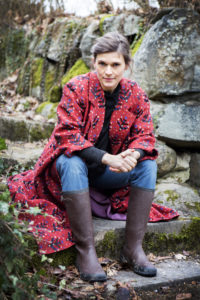
The Ice Sea Pirates, her most translated book, is available in 20 languages.
(And then we popped in a question for Julia Marshall, translator of the Hattie series.)
Nilsson’s early career was in TV and radio. She wrote and produced children’s radio and did some translation work herself—some small books and “many-many-many episodes of TV cartoons”. “I know that it’s hard work to do it well. I also know that it’s hard for translators to get fairly paid for their work and that’s really a shame.”
How does it feel to have a book translated into a language you don’t know—is it a loss of control or do you feel relaxed about it?
I feel sort of terrified and relaxed at the same time, because I have no idea what happens to my texts—but also no way of finding out, unless I learn 20 languages!
What about translations into a language like English that you do speak?
It basically just means more work! I can read the text before it’s printed and comment on it. I do this if I have the time, but if I’m in the middle of writing a new book, I just let it go.
How is does it feel to be “translated” into film, as with your book The Ape Star. What do you enjoy—or not—about this process?
The only difficult thing is contracting the film rights. This takes a long time and the negotiations can be intense, because I know that, when I finally sign over the rights, I won’t have a say on anything in the process. I have to just let go of it and give it to the director because it’s their story after that. Of course it’s exciting and inspiring to see someone else that loves your story take it on and develop it.
And being translated into radio?
But the mermaids and the bogle birds weren’t random; I took a lot of care creating this world. The mermaids, for instance, are a mix between walrus and human, and the bogle birds I found on a website about prehistoric animals. These bogle birds had toothed beaks and ate stones so they would become heavy enough to reach the bottom of the sea to find food.
Did you read a lot as a child?
I grew up way out in the country with no brothers or sisters, and hardly any neighbours. Because there weren’t any children around, and because my father, who worked as a journalist, always brought home lots of books (review samples), I read a great deal. I have very strong memories from that time in my life, very strong memories about how it was to be completely “devoured” by a story. Reading now is not the same thing for me. I know I will never be absorbed like I could be then and, in a way, that makes me sad. But I think my writing is a kind of substitute for that sort of reading, and a way to cling on to my years as a child—a most happy time.
Julia Marshall is the translator of the Hattie series: What is it like to translate Frida’s Hattie books?
5 Swedish children’s books translated into English recommended by Frida Nilsson
- Ronia, The Robber’s Daughter by Astrid Lindgren
- Moominpappa at Sea by Tove Jansson (Jansson was from Finland but wrote in Swedish)
- The White Stone by Gunnel Linde
- Soda Pop by Barbro Lindgren
- Josephine by Maria Gripe
The Gecko Press monthly newsletter has all of our latest blog articles, news, competitions and more. Sign up to our mailing list here.
